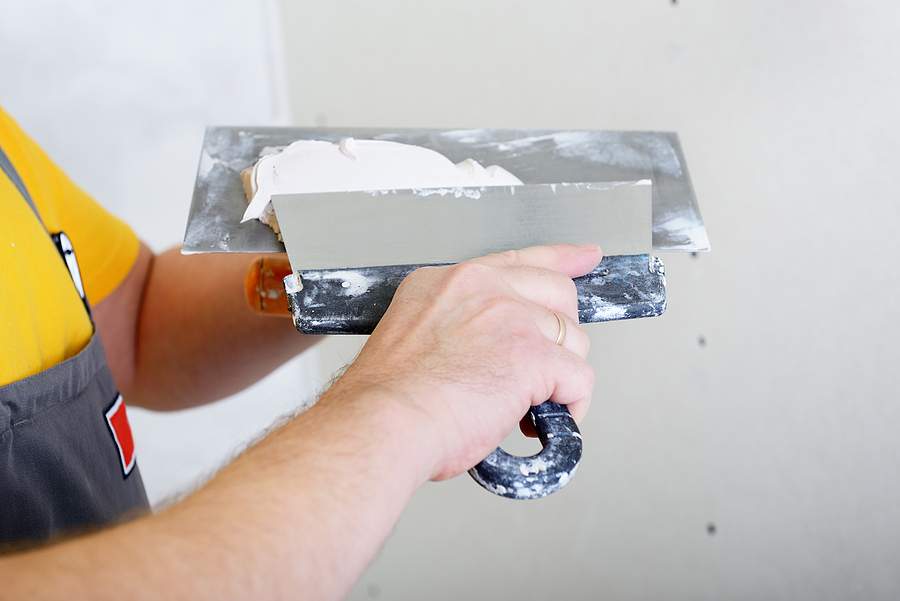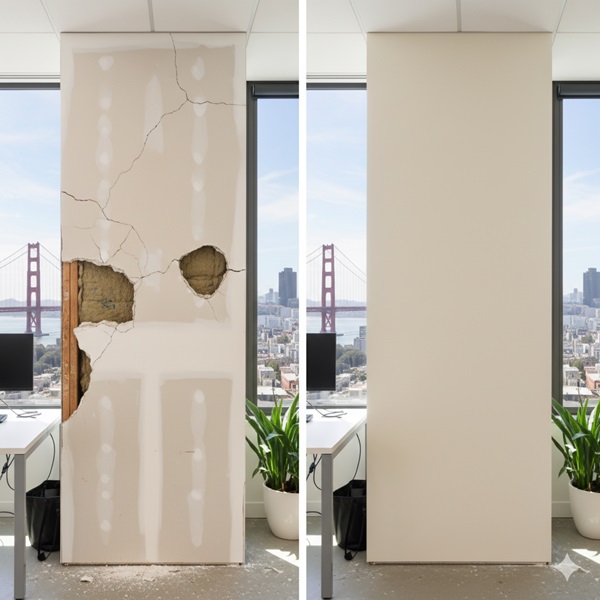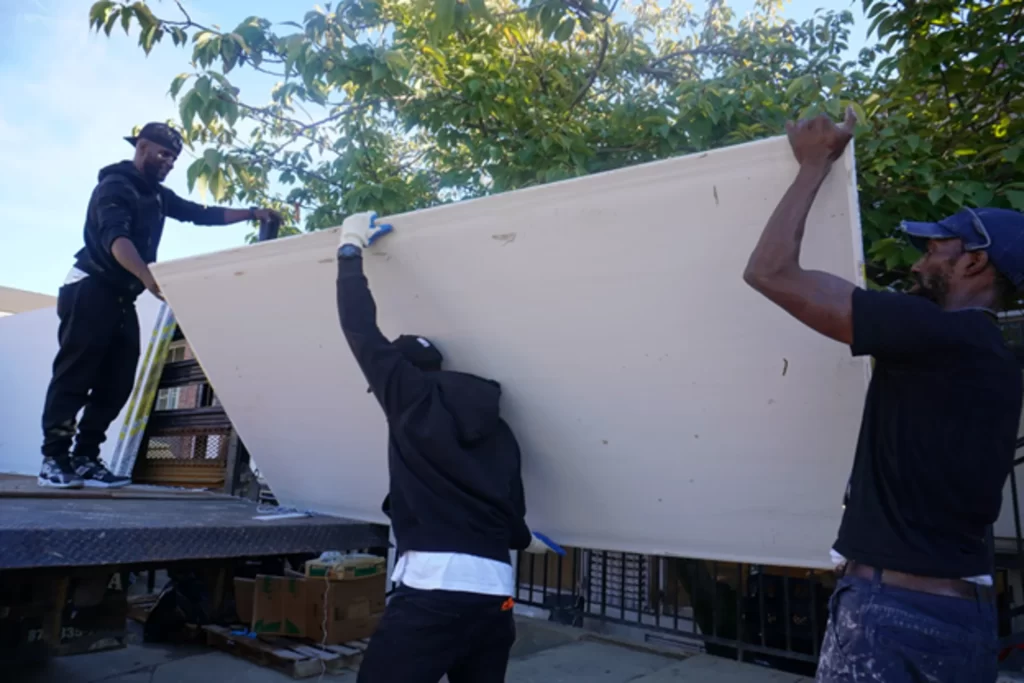A Comprehensive Guide to Learning Drywall Fixing and Setup
This overview supplies a complete exploration of drywall repair and installment, catering to both newbies and skilled professionals. It lays out necessary devices, strategies for patching and hanging sheets, and the vital finishing procedures. Drywall Repair Ogden UT. By comprehending common risks, people can accomplish polished outcomes. Grasping these skills not only improves one's home yet additionally develops self-confidence in do it yourself endeavors. What foundational ideas will guarantee an effective job from beginning to finish?
Crucial Tools for Drywall Repair Work and Setup
When starting on drywall repair and setup, a few vital devices can greatly enhance the efficiency and high quality of the work. A drywall blade, commonly readily available in different sizes, is important for applying joint compound and smoothing joints. A taping knife is also needed for feathering edges and guaranteeing a smooth surface. In addition, a drywall saw or energy knife permits exact cutting of drywall sheets to fit any type of space.

Step-by-Step Guide to Patching Holes
Patching openings in drywall is a straightforward process that can recover the wall's look and stability. To begin, the area around the hole need to be cleansed and any loosened particles got rid of. For tiny holes, a basic spackle or joint substance can be used with a putty knife. Larger holes may need a spot; a piece of drywall can be cut to fit the opening, safeguarded with glue or screws, and afterwards taped around the sides. When the spot remains in place, joint compound is applied over the patch and feathered out to blend with the surrounding wall. After the substance dries out, fining sand is essential to accomplish a smooth coating. The fixed location can be topped and repainted to match the remainder of the wall. This technique ensures a seamless repair work, improving the total appearance of the drywall and keeping its structural integrity.
Techniques for Hanging Drywall Sheets
After effectively repairing holes in drywall, the following action includes hanging brand-new drywall sheets to produce a smooth surface area. To accomplish this, one need to begin by determining the wall area precisely and reducing the drywall sheets to fit. It is essential to hang the sheets horizontally for better architectural honesty, beginning from the top and working downwards.
Making use of a drywall lift can streamline the procedure, especially for ceiling setups. As soon as placed, safeguarding the sheets with drywall screws at periods of concerning 12 inches along the sides and 16 inches in the area is essential. This guarantees a solid hold and decreases the risk of drooping. For corners, the sheets must be cut to fit comfortably, permitting cleaner seams. Ultimately, it is a good idea to stagger the joints in between sheets to strengthen the total structure, creating a much more resilient coating all set for the following stage in the drywall installation process.
Ending Up Touches: Insulation and Mudding
Completing the drywall check here setup involves the vital steps of taping and mudding, which guarantee a smooth and sleek surface. Insulation requires the application of joint tape over the joints between drywall sheets. drywall contractors. This tape can be either paper or fiberglass fit together, with each kind offering unique benefits. After taping, the next action is mudding, where joint substance, or "mud," is put on cover the tape and fill any blemishes
Making use of a drywall blade, the substance should be spread equally, making sure a feathery edge to lessen noticeable modifications. Several layers are frequently required, with sanding in between each layer to accomplish a seamless surface. Cautious interest throughout this procedure is essential, as it substantially influences the final look of the wall surface. With the right method and persistence, completion outcome will certainly be a remarkable foundation ready for painting or completing touches.
Typical Blunders to Stay Clear Of in Drywall Projects

Another common error is not permitting sufficient drying time in between layers, which can catch wetness and endanger the finish. Ignoring to feather the edges appropriately can produce noticeable lines and imperfections. Finally, skipping sanding or using inappropriate strategies might leave rough spots. By knowing these risks, individuals can significantly improve the high quality of their drywall jobs and accomplish a professional-looking surface.
Frequently Asked Concerns
Can I Repair Drywall Without Specialist Aid?
Yes, one can fix drywall without specialist help. With the right tools, materials, and support, people can successfully manage minor fixings. Significant damages may call for specialist expertise for excellent outcomes and toughness.
For How Long Does Drywall Substance Require To Dry?
Drywall compound typically takes between 24 to two days to completely dry totally, depending on variables such as humidity and temperature level. Thinner layers might dry out faster, while thicker applications need even more time for suitable results.
What's the very best Sort Of Paint for Drywall?
The ideal kind of paint for drywall is normally a water-based latex paint. It offers superb coverage, sturdiness, and convenience of application, making it suitable for indoor walls while enabling very easy cleanup with soap and water.

Just how Do I Protect Against Mold And Mildew on Drywall?
To stop mold on drywall, assurance proper ventilation, control humidity levels, utilize mold-resistant materials, and immediately address any leakages. Routine assessments and immediate remediation of water damage are additionally essential for long-lasting avoidance.
Is Drywall Recyclable After Elimination?
Drywall is recyclable after elimination, offered it is without impurities like mold and mildew, paint, or other dangerous materials. Reusing centers can refine it right into new products, advertising sustainability and minimizing garbage dump waste in building.
When beginning on drywall repair service and installation, a couple of essential devices can significantly boost the effectiveness and top quality of the job. After successfully repairing openings in drywall, the next action entails hanging new drywall sheets to create a smooth surface. Finishing the drywall installation entails the essential steps of mudding and taping, which ensure a smooth and polished coating. Attaining a refined coating in drywall jobs can be challenging, and a number of common blunders can weaken the quality of the work. Yes, one can repair drywall without specialist help.